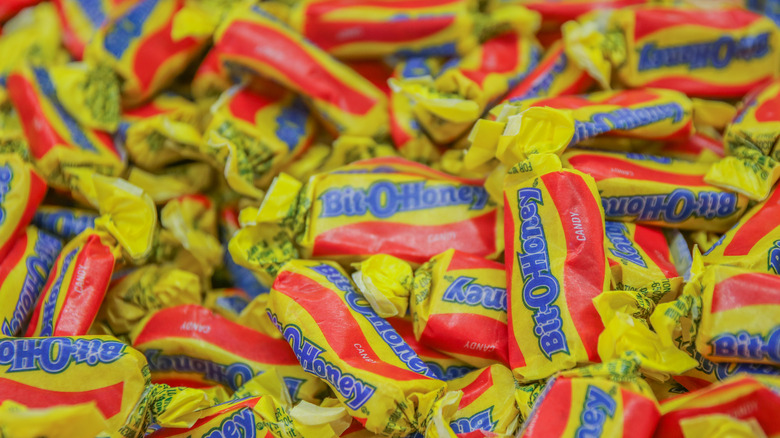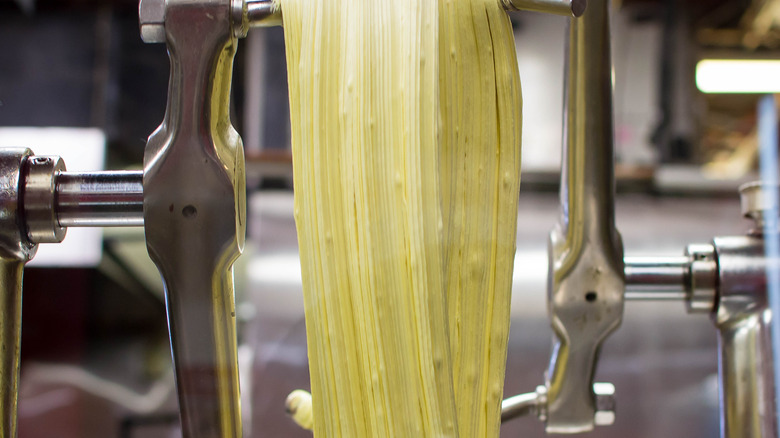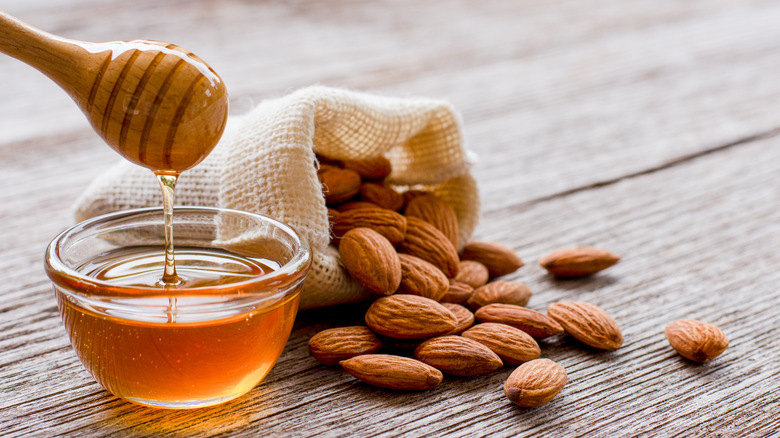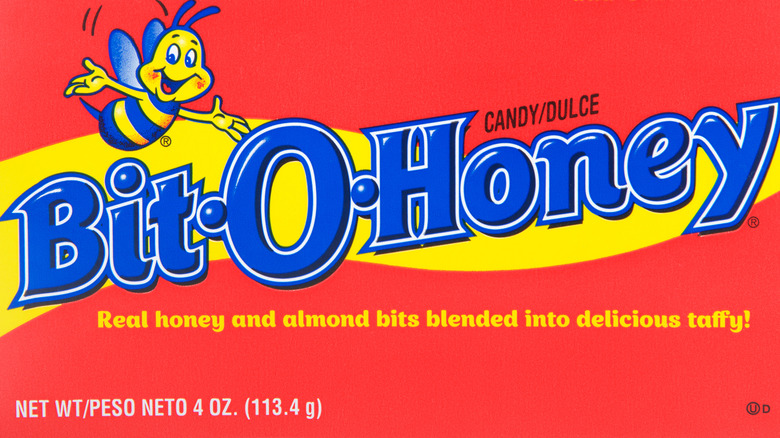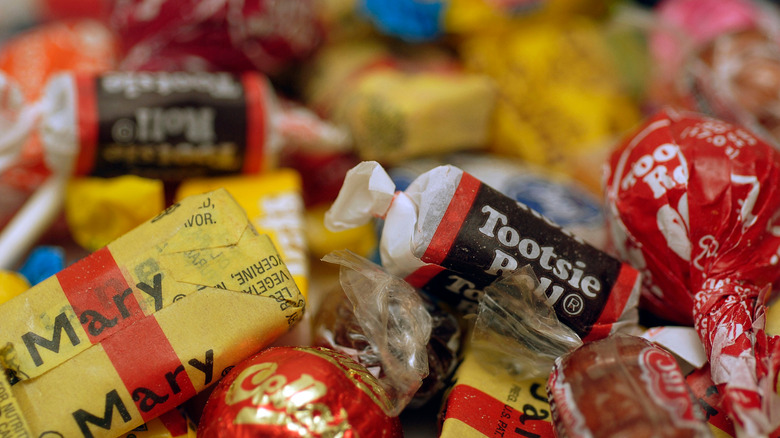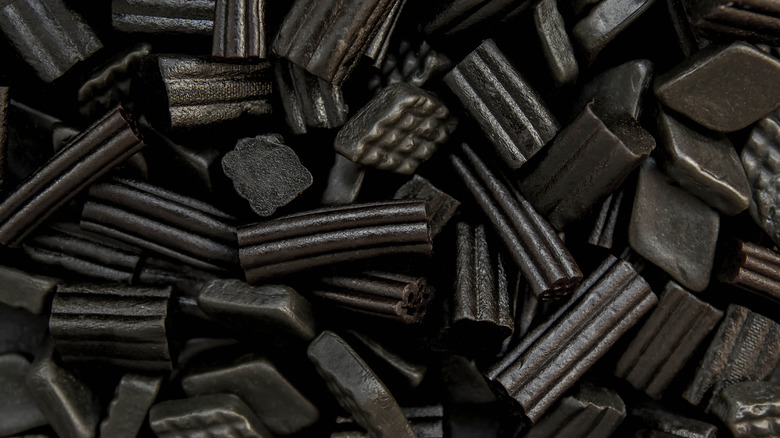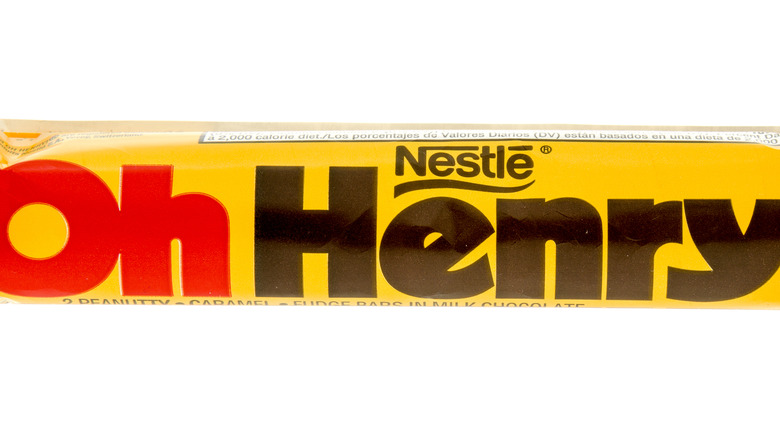The Untold Truth Of Bit-O-Honey
Let's be honest: Bit-O-Honey is admittedly not the sexiest candy bar on the shelf. Who didn't find themselves pawning off these little morsels when they landed in their Halloween baskets, attempting to trade them for something featuring a more tantalizing ingredient like caramel or peanuts or chocolate?
But don't be fooled: This candy bar has stood the test of time for nearly 100 years, and with such longevity, it must have something good going for it.
And indeed it does. As its name suggests, Bit-O-Honey is a honey-based confection studded with almonds. Chewy and dense, a little bit of Bit-O-Honey goes a long, long way. (Seriously, it's known for getting stuck in your teeth.) And despite having a sort of "always the bridesmaid, never the bride" status, this candy bar has a long history and nostalgic appeal that makes it beloved by many. It's well overdue for a reputation revamp!
Bit-O-Honey is technically taffy
Bit-O-Honey is quite a bit simpler than many other candy bars, with a relatively short ingredients list and just one main texture: the dense chew of taffy.
Given its name, it's perhaps unsurprising that taffy is related to toffee. As professional candy maker and candy blogger Mr Dach explains, the two words were once interchangeable, until, in the 19th century, candy makers began "pulling" the dense, chewy treat to make it "lighter and softer." Not unlike a sewing circle, the pulling of taffy later became "social events" where people would get together in groups to make candy and gossip. That said, it probably wasn't easy to gossip and chew on pieces of taffy at the same time: As anyone who has eaten it will tell you, the candy is known for its cling-to-your-molars texture.
The taffy at the heart of Bit-O-Honey is made with a combination of corn syrup, sugar, milk, coconut oil, egg whites, and honey or honey flavoring. Shards of almond provide a bit of crunch and nuttiness, and the resulting mixture is sold either in bars pre-divided into six portions or, more commonly these days, in small, individually wrapped morsels.
Bit-O-Honey is made with real honey and almonds
When it comes to candy and other confections, manufacturers often opt for a cheaper alternative to the real fruit or nuts. But Bit-O-Honey boasts both real honey and real almonds and has since its inception!
The almonds are included in little bits or shards, which provide a nice textural contrast to the soft chewiness of the taffy base of this candy. They're the sixth ingredient on the ingredients list (out of fourteen), so there's definitely a bit of almond in every bite.
As for the eponymous honey, it's certainly present, albeit as less than 2% of the finished product. Much of the sweetness of this candy comes, unsurprisingly, from corn syrup, which is the first ingredient listed on the package. But make no mistake: since honey naturally has a rich, floral aroma, a little bit goes a long way, and these little bites do indeed taste like honey!
Bit-O-Honey was invented just before the Great Depression
Bit-O-Honey's nostalgic appeal is no coincidence. This candy has been around for a long time — indeed, it's almost 100 years old! Per OldTimeCandy.com, Bit-O-Honey was invented just before the Great Depression, in 1924 – the same year that Dum-Dums lollipops joined the sweets scene. The brainchild of Schutter-Johnson candy company, also known for its bubble gum (and associated collectible cards), Bit-O-Honey soon became famous for its long-lasting nature, with a slogan that touted that "every bit of Bit-O-Honey goes a long way."
Bit-O-Honey stood out from competitors from the beginning, devoid as it was of the chocolate that made many other candies of the time so popular. And as scarcity took hold during the Depression, you can bet that a candy that took forever to consume (and ended up stuck in your teeth) was just the kind of confection people were clamoring for.
Bit-O-Honey is distinct from Mary Jane
Bit-O-Honey is a fairly unique confection, and yet people often compare it to another sweet: Mary Jane. Both candies, after all, boast a taffy base and, in their most popular forms, are sold in single-bite portions wrapped in yellow wax paper.
But Mary Jane has a few unique characteristics that make it stand out from Bit-O-Honey. Firstly, it's older. As Candy Warehouse recounts, it was invented by Charles Miller in Boston in the late 19th century. There's been some debate about the name's backstory: The creator said he named it "after his favorite aunt," but legend has it he actually named it after a character from the Buster Brown comic series "to get free advertising in the weekly newspaper funnies alongside Buster Brown comic strips." However, as Mental Floss points out, "there's no hard evidence to support this theory."
In addition to being older than Bit-O-Honey, Mary Jane stands out thanks to its flavor. Made not with honey and almonds but with molasses and peanut butter, Mary Jane boasts a richer, earthier flavor.
There used to be other Bit-O-Honey flavors like chocolate, licorice, and peanut butter
Today, Bit-O-Honey is available in only one flavor — that suggested by its name. However, that wasn't always the case. Back in the day, there were a few other options on offer.
After the inventor of Bit-O-Honey, Schutter-Johnson, merged with Ward Candy Company in 1969, alternative flavors of the sweet like Bit-O-Chocolate, Bit-O-Peanut Butter, and even Bit-O-Licorice were launched beginning in the '70s. But while chocolate and peanut butter are certainly popular candy flavors in America, and fan-favorite Mary Jane had already combined taffy and peanut butter to much acclaim, these Bit-O-Honey alternatives never really caught on, and none of the new flavors ever lived up to the hype of the original.
As CandyFavorites.com recalls, Bit-O-Chocolate, Bit-O-Peanut Butter, and Bit-O-Licorice were all eventually discontinued due to lack of interest, and today, only the original star flavor — honey — remains.
Bit-O-Honey has changed hands many times
While it was first invented by Schutter-Johnson, Bit-O-Honey has actually changed hands many times over its nearly 100-year history. As CandyFavorites.com recounts, the first major switch came in 1969, when Schutter-Johnson merged with Ward Candy Company. The New York-based confectioner was known for candies like Chunky, Oh Henry!, and Raisinets. It was at this time that other Bit-O-Honey flavors like licorice, peanut butter, and chocolate were launched, in an attempt to widen the appeal of the brand.
In 1984, several Ward candy brands — including Raisinets and Bit-O-Honey — were purchased by Nestle. Nearly 30 years later, in 2013, Bit-O-Honey was sold to Minneapolis' Pearson's Candy Company, known for its salted nut roll.
As reported by Candy & Snack Today, the brand finally landed at its current home, Spangler Candy, in late 2020. Spangler also makes other retro faves like Dum-Dums, Sweethearts, Necco Wafers, Circus Peanuts, and more, so it's the perfect home for this nostalgic candy.
The Bit-O-Honey honeybee is relatively new
It might seem obvious to include a honeybee on a product with honey at the heart of its identity, but it actually took over 50 years for the trademark bumblebee to grace Bit-O-Honey's packaging.
In the late '70s, after the merger between the Schutter-Johnson and Ward candy companies, the bumblebee was added in a nod to the main flavor of the candy, per CandyFavorites.com. While it's unclear who came up with the idea, it's concurrent with the introduction of other food mascots like Count Chocula, Franken Berry, Boo Berry, Quicky the Nesquik bunny, and the Vlasic stork, per CBS News.
Not unlike other food spokescharacters, the bee has undergone a few makeovers to reach the cute, friendly mascot the brand finally settled on. Earlier iterations of the bee — such as the one that appeared on a tee that was available on Depop — show the buzzy buddy with its tongue sticking out. That illustration would pave the way for the bee's familiar smile.
